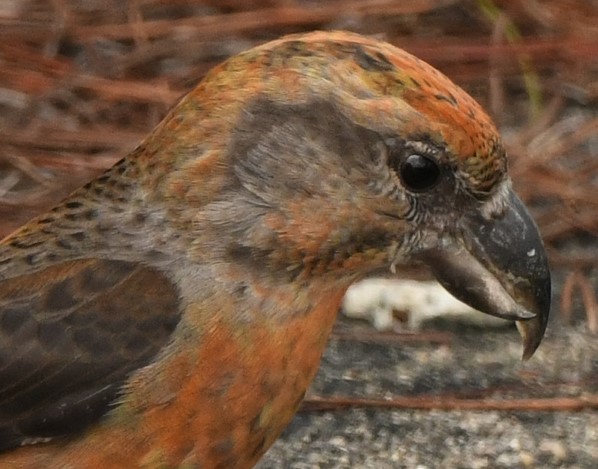
Link to DaLat Plateau Seasonal Summary Reports: 2019-20; 2022-23; 2023-24
DaLat Plateau, Lam Dong, Vietnam: 5 June – 9 August 2019
Callyn Yorke

The summer of 2019 in Da Lat was refreshingly cool and breezy compared to most of Vietnam, which typically swelters under high heat and humidity. At about 5,000 ft. above sea level, Da Lat weather feels more like springtime in the San Francisco Bay Area than almost anywhere else in Vietnam. Summer (June-August) is the season of increasing rainfall due to the southern monsoon. That’s actually good news for local birders, because occasional thunderstorms stimulate bird activity. Immediately prior to and following heavy rains can be incredibly exciting, as waves of multiple bird species move through the forest. Indeed, the highland forests on the Da Lat Plateau harbor one of the richest assemblages of endemic bird species to be found anywhere in mainland Southeast Asia (see the following images for examples). Visiting birders usually leave this area having encountered some of the most sought-after specialties of the region, e.g. laughingthrushes and babblers.

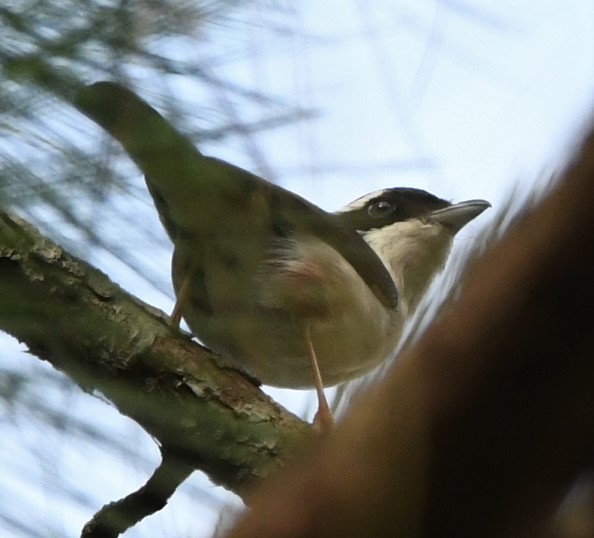
Sensibly, field equipment in this region should always include rain gear; waterproof and fog proof binoculars are essential. Weather conditions are predictably unpredictable and within minutes can range from sunny and warm to fierce squalls with torrential rain (c.f. photos from same location on 8 June 2019).

Likewise, photography conditions vary from softly subdued, overcast skies, to blindingly harsh with contrasting dark shadows. Constant monitoring of exposure and shutter speed is needed. But even with optimal lighting, often only fleeting glimpses of birds are obtained; most species are inherently shy and retiring. To sum up, birding and bird photography in Vietnam is challenging.

Of course, one of the reasons birds in Vietnam seem surprisingly shy is doubtless due to widespread trapping for the lucrative caged-bird market. Stacks of cages packed with panicked songbirds line the streets of Da Lat; most homes have one or two caged birds on display. Owning a caged bird or two, especially one that is a good songster, is thought by Vietnamese to brighten up a home and perhaps bring spiritual benefits.

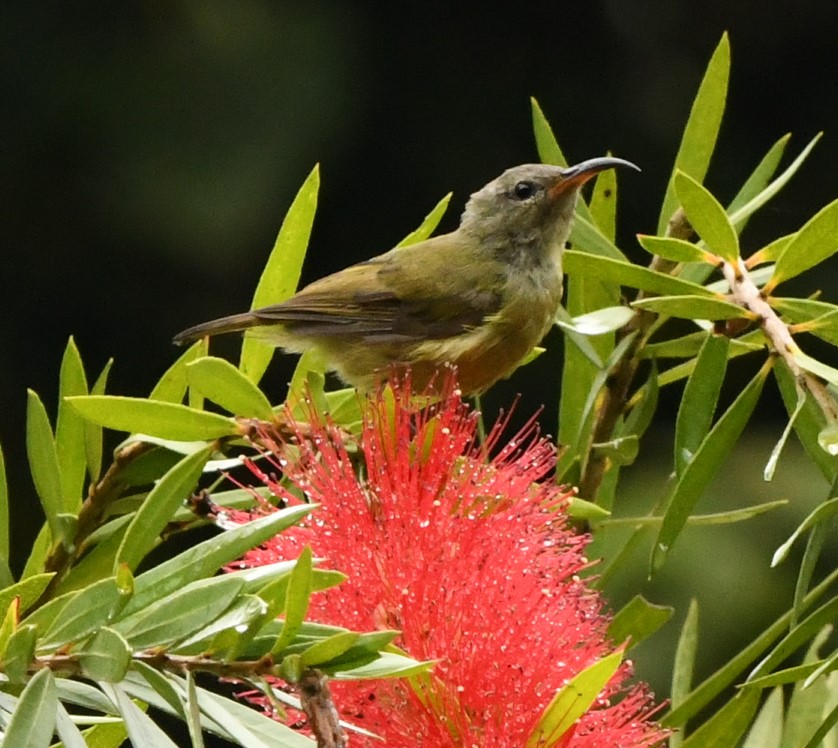
Unfortunately, this deeply ingrained cultural tradition in Vietnam (and elsewhere in SE Asia) has resulted in massive declines of songbird populations, particularly around major towns and cities. Although laws officially protect the wild birds of Vietnam, sadly, they are seldom enforced. For this reason, I have chosen to refer to unprotected birding locations around Da Lat only in the vaguest terms, or with completely fabricated names, abbreviations, e.g. “Bidoup National Forest, BNF,” ” Three Little Pigs Road, 3LP, “and “Tuyen Lam Lake, TL.”
“Forests are gold. If we know how to protect and develop them well, they will be very precious.” – Ho Chi Minh, 1963.
My aim, through these texts and images, is to help raise awareness and appreciation of the wonderful diversity of birds and other wildlife resources found in Vietnam. I have lived and traveled throughout SE Asia, and in my experience there is no other country in Southeast Asia with a greater display of breathtaking scenery, geographical diversity, and high proportion of endemic species, than Vietnam.


However, only through a combination of public education and economic incentives derived from the development of sustainable ecotourism, shall significant progress toward natural resources conservation be made in Vietnam. I am optimistic that such lofty and idealistic goals may be reached for the betterment of all Vietnamese, now and in the future.

ANNOTATED BIRD LIST OF THE DA LAT PLATEAU June – August, 2019 Callyn Yorke
Key
Areas Covered & Survey Dates (day/month): Da Lat Botanical Garden (DBG 13/6); DaLat District 6 -home (DL6 5/6-9/8); Da Lat University Campus (DUC 19/7); Lang Bian Mt. summit trail (LB 7/6 ); Tuyen Lam Lake – multiple locations (TL 16/7;23/7;10/6;27/6); Ta Nung Valley (TN 22/7;25/6;27/6;29/6;29/7;9/8); Three Little Pigs Road (3LP 5/6;6/6;8/6;9/6;24/6;26/6;13/7;14/7;17/7;18/7;21/7;24/7;28/7); Bidoup National Forest (BNF 28/6; 30/6). Pang Tien & Elvis on the Hill Resort (PT & EH 26/7); Pon Gur and Dam Bri Waterfalls (PW & DB 12/6).
Count: Actual (1-12) or estimated (> 12) number of individuals; maximum count value given for areas visited repeatedly.
Morphology, Behavior and Ecology: Sex (if known) Male (m); Female (f); Age (if known): Adult (ad), immature (imm); Gregarious (GRG), Vocal (Vocal – calls and/or song); Mixed species flock (MSF), Gleaning food items from ground, foliage, bark, etc. (GLN); Drilling, pecking and penetrating surface, e.g. tree bark (DR); Aerial hawking (AH); Responsive to playback of its vocalizations (RTP); outer canopy (CAN); subcanopy (SCAN), Middle level (ML), Understory (U); open field, farmland, mixed scrub (OF); Forest edge and second-growth (FE); Forest interior (FI). Broadleaf evergreen trees and/or shrubs (BEF), Conifers (CF).
Weather: Frequent, variable cloudiness, rain (mostly light, occasionally heavy) & wind (usually 0-2 mph, occasionally with gusts of > 20 mph); a few survey days with mostly sunny and warm weather: 55F to 80F, avg. 72F.
Time: 0600 – 1830 hrs. (most surveys completed by 1200 hrs.).
Observers: Da Thao Le Nguyen and Callyn Yorke; Duyen Vutrong and CY (27-28/6).
Optical Equipment: Zeiss 10 x 42 and 8 x 42 binoculars; Nikon D850 with Nikon 200-500 mm AF VR lens; Google Pixel 3X cell phone.
BIRDS NOTED (Vietnamese endemics and near-endemics in bold type)
- Chinese Spot-billed duck (Anas zonorhyncha) 12- cont. domesticated resident, gregarious, edges of main pond, TN.
- Little Grebe (Tachybaptus ruficollis) 2 diving near shore, TL.
- Feral Rock Pigeon (Columba livia) 10 DBG; 6 TN; widespread in urban areas.
- Eastern Spotted Dove (Spilopelia chinensis) 10 widespread, gregarious and common in developed areas and fields, DL6, TN, 3LP, TL.
- Zebra Dove (Geopelia striata) 2 on ground at edge of parking lot, DB; 2; 2 on ground in village near 3LP; 2 courtship behav. on garden patio, DUC.
- Wedge-tailed Green Pigeon (Treron sphenurus) 8 gregarious in favored, fruiting deciduous tree, 3LP (photo).

- Thick-billed Green Pigeon (Treron curvirostra) 12 gregarious in canopy of emergent fruiting tree, TN.
- Mountain Imperial Pigeon (Ducula badia) 1 in flight over BEF, TN.
- Barred Cuckoo-dove (Macropygia unchall) 1 vocal (unseen) TN.
- Germain’s Swiftlet (Aerodramus germani) 10 TN; 2 DUC.
- House Swift (Apus nipalensis) 120 large, active colonies in rafters and high openings two-three level older buildings, D6, DUC; 25 DB.
- Asian Palm Swift (Cypsiurus balasiensis) 3 ID: slender wings w/ pointed tail, 3LP.
- Greater Coucal (Centropus sinensis) widespread in farmland and weedy fields.
- Green-billed Malkoa (Phaenicophaeus tristis) 2 3LP, TN.

- Plaintive Cuckoo (Cacomantis merulinus) vocal (unseen) DL6.
- Common Moorhen (Gallinula chloropus) 5 gregarious in weedy pond, DBG.
- Cattle Egret (Bulbucus ibis) 20 roadside paddifields, PW.
- Little Cormorant (Microcarbo niger) 2 perched on snag in shallows, TL.
- Crested Serpent-eagle (Spilornis cheela) 1 circling above BEF, 3LP.
- Black Eagle (Ictinaetus malaiensis) 1 ad. circling above a mosaic of BEF, CF and farmland, PT.
- Crested Goshawk (Accipiter trivirgatus) 1 circling above BEF and CF, 3LP.
- Red-headed Trogon (Harpactes erythrocephalus) 1 perched in BEF subcanopy, BNF; 1 DF edge, subcanopy TN.
- Eurasian Hoopoe (Upupa epops) 4 loosely gregarious, PW.
- Common Kingfisher (Alcedo atthis) 1 back pond, DUC; 1 roadside pond, PW.
- White-breasted Kingfisher (Halcyon smyrnensis) 1 DL6; 1 adjacent farmland with pond, 3LP.
- Annam Barbet (Psilopogon annamensis) 2 frequently vocal, 3LP; 2 TN (photo -see introduction)
- Red-vented Barbet (Psilopogon lagrandieri) 1 vocal (unseen) TN.
- Necklaced Barbet (Psilopogon auricularis) 1 repeated calls & RTP, (unseen) 3LP.
- Speckled Piculet (Picumnus innominatus) 1 TL; 1 3LP.
- Bay Woodpecker (Blythipicus pyrrhotis) 1 3LP; 1 TL.
- Black-naped Woodpecker (Picus guerini) 1 vocal (unseen) TN.
- Greater Yellownape (Chrysophlegma flavinucha) 1 TL.
- Gray-capped Woodpecker (Picoides canicapillus) 1 LB; 1 3LP; 2 TL; 1 PW.
- Rusty-naped Pitta (Hydrornis oatesi) 2 (ad, imm) late morning in shady EF floor, BNP (photo).

- Long-tailed Broadbill (Psarisomus dalhousiae) 1 subcanopy EF, 3LP.
- Maroon Oriole (Oriolus traillii) 2 (m,f), imm subcanopy and vined BEF second-growth, 3LP; 1 TN (photo).

- DaLat Shrike-babbler (Pteruthius annamensis) 1 subcanopy CF, TN (photo – see intro.)
- White-bellied Erpornis (Erpornis zantholeuca) 1 msf mid-level BEF, 3LP; 1 TN.
- Gray-chinned Minivet (Pericrocotus solaris) 1 (m) perched atop snag, BEF, 3LP.
- Black-winged Cuckoo-shrike (Lalage malaschistos) 1 on horizontal limb of large pine, TN.
- Indochinese Cuckoo-shrike (Lalage polioptera) 1 CF edge, TL.
- Bar-winged Flycatcher-shrike (Hemipus picatus) 3 often in msf, BEF, 3LP; TN (photo)
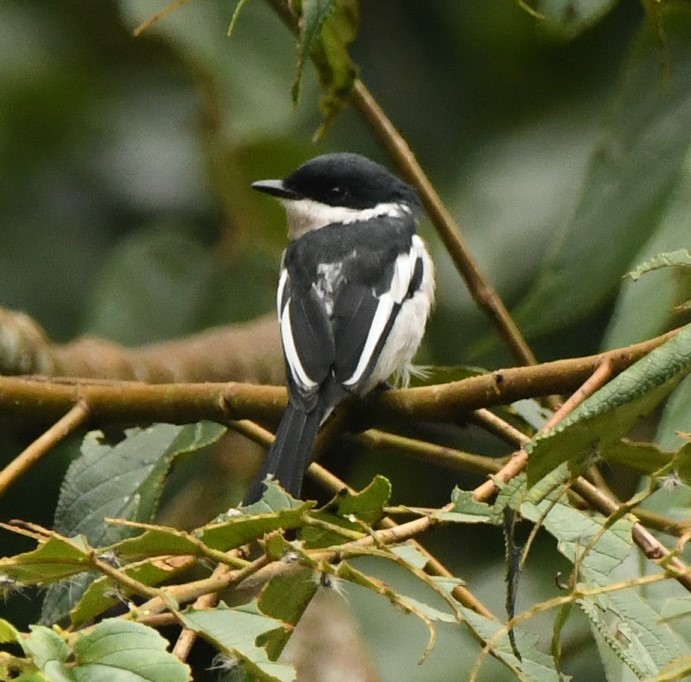
- Common Iora (Aegithinia tiphia) 2 widespread; gardens, secondary BEF, 3LP, DL6, TN, TL.
- White-throated Fantail (Rhipidura albicollis) 2-4, widespread; gardens, secondary BEF forest, 3LP, DL6, TN, DUC.
- Sooty Drongo (Dicrurus leucophaeus) 2-3, widespread; gardens, secondary BEF and CF forest, 3LP, DL6, TN, DUC.
- Bronzed Drongo (Dicrurus aeneus) 3 edge of secondary BEF, TN (photo)

- Lesser Racquet-tailed Drongo (Dicrurus remifer) 2 secondary BEF, 3LP, TN, TL.

- Burmese Shrike (Lanius collurioides) 2 widespread; gardens, OF, DL6, DUC, DBG.
- Gray-headed Canary-flycatcher (Culicicapa ceylonensis) 2 edge of BEF, often in msf, 3LP, TN.
- Langbian Tit (Parus legendrei) 3 vocal, gregarious (pairs) usually in CF canopy, 3LP; LB.
- Hill Prinia (Prinia superciliaris) 4 vocal, widespread; gardens, OF, vacant lots with second-growth, DL6, 3LP, TN (photo).

- Dark-necked Tailorbird (Orthotomus atrogularis) 4 vocal, widespread; gardens, BEF forest edge, second-growth, 3LP, TN, TL.
- Eurasian Barn Swallow (Hirundo rustica) 10 loosely gregarious over BEF and OF, 3LP; TN.
- Brown-backed Ashy Bulbul (Hemixos remotus) 2 often in msf, BEF subcanopy and middle level, 3LP, TN.
- Southern Mountain Bulbul (Ixos tickelli) 2 often joining msf, BEF 3LP, TN, LB (photo).

- Black Bulbul (Hypsipetes leucocephalus concolor) 12 gregarious, vocal, widespread in BEF and CF, 3LP, TN, TL, LB.
- Black-crested Bulbul (Pycnonotus flaviventris) 2 often in msf, middle to upper level BEF, 3LP, TN, LB.
- Red-whiskered Bulbul (Pycnonotus jocosus) 2 widespread, local, increasingly scarce due to trapping for the cage-bird trade, 3LP, TN, TL.
- Southern Sooty-headed Bulbul (Pycnonotus aurigaster) 5 widespread, OF, edge of BEF, CF, TN, 3LP, TL, DUC, LB.
- Flavescent Bulbul (Pycnonotus flavescens) 3-5 gregarious, widespread, second-growth, BEF edge of CF, 3LP, TN, TL, BNF, LB (photo).
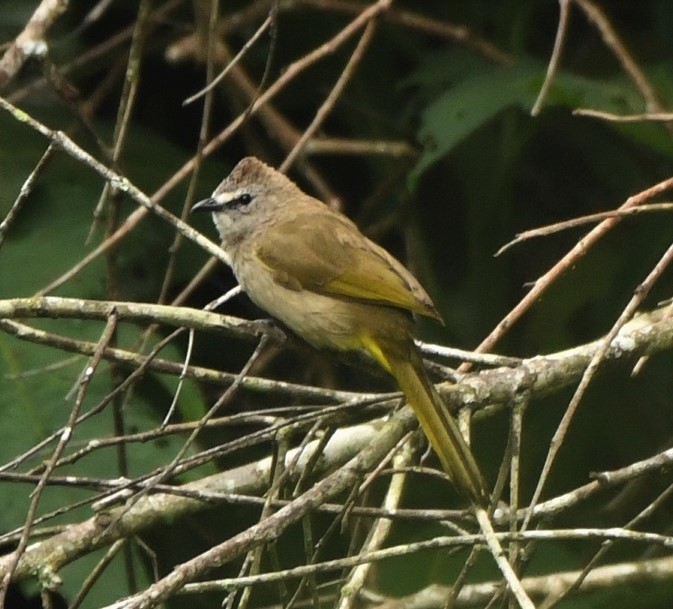
- Sunda Yellow-vented Bulbul (Pycnonotus goiavier) 1 edge of BEF and OF, 3LP, TN.
- Kloss’s Leaf Warbler (Phylloscopus ogilviegranti) 3 often in msf, BEF, CF, 3LP, TN (photo).

- Gray-bellied Tesia (Tesia cyaniventer) 2 DF floor, dense understory, shy, vocal, RTP, 3LP, TN.
- Mountain Tailorbird (Phyllergates cucullatus) 2 vocal, shy, RTP, edge of BEF, 3LP, TN.
- Gray-crowned Tit (Aegithalos annamensis) 6 gregarious, vocal, edge of CF, BEF, lower to middle levels, 3LP, TN, LB.
- Black-headed Parrotbill (Psittiparus margaritae) 1 msf, subcanopy, edge BEF, CF 3LP.
- Black-chinned Yuhina (Yuhina nigrimenta) often in msf, middle to lower levels, BEF, CF edge, 3LP, TN.
- Oriental White-eye (Zosterops palpebrosus) 4 gregarious, widespread, gardens, second-growth, BEF, CF, 3LP, TL, DL6, DUC, DBG.
- Red-billed Scimitar-babbler (Pomatorhinus ochraceiceps) 1 vocal, RTP, middle to upper level BEF, 3LP.
- White-browed Scimitar-babbler (Pomatorhinus schisticeps) 1 BEF understory and middle level, BNF (photo)

- Northern Gray-throated Babbler (Stachyris nigriceps) 1 DF understory and ground, 3LP, TN, BDF (photo).

- Chestnut-capped Babbler (Timalia pileata) 6 gregarious, vocal, shy, tall grass and shrubs in scrubby second growth ravine with a small stream, PT (photo).
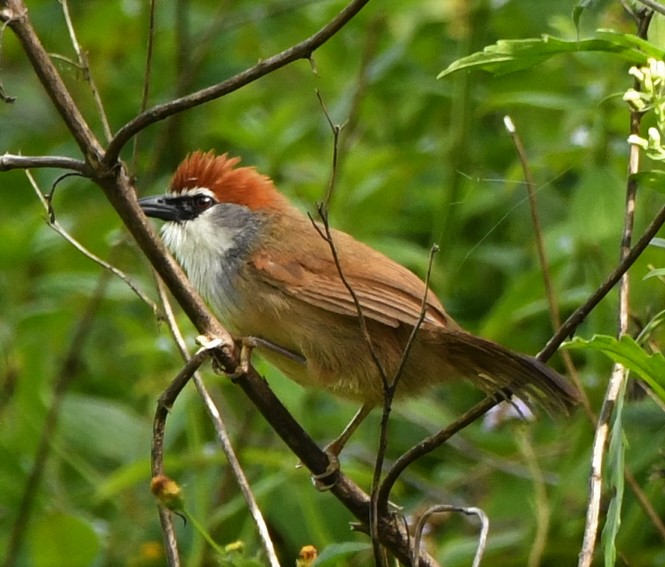
- Gray-faced Tit-babbler (Mixornis kelleyi) 1 BEF understory edge, TN.
- Rufous-capped Babbler (Cyanoderma ruficeps) 1 often in msf, BEF understory to middle level, 3LP, TN.
- Black-crowned Fulvetta (Schoeniparus klossi) 1 BEF middle level, msf, 3LP.
- Mountain Fulvetta (Alcippe paracensis) 2 foraging on berries, scrubby second-growth, edge CF/BEF, 3LP, TN (photo).

- Vietnamese Cutia (Cutia legalleni) 5 gregarious, canopy of CF, TL, TN (photo – see intro).
- Orange-breasted Laughingthrush (Garrulax annamensis) 2 gregarious, BEF understory and middle level, shy, occasionally vocal and RTP, TN (photo).

- Black-throated Laughingthrush (Garrulax chinenis) vocal (unseen) TL.
- White-cheeked Laughingthrush (Garrulax vassali) 30-40 widespread, gregarious, vocal, second-growth, understory and middle CF, BEF edge, 3LP, TN, BNF, DUC (photo).

- Collared Laughingthrush (Trochalopteron yersini) 3 gregarious, shy, BEF ground to middle level, BNF (photo).

- Silver-eared Mesia (Leiothrix argentauris) 1 msf, middle level BEF, 3LP (Note: becoming scarce due to trapping).
- Black-backed Sibia (Leioptila eximia) 4 vocal, loosely gregarious, edge BEF, 3LP, TN.
- White-spectacled Sibia (Heterophasia robinsoni) 3 gregarious, BEF understory and middle levels, often in msf, 3LP, TN, BNF (photo).

- Plain Minla (Siva cyanouroptera orientalis) 4 gregarious, often joining msf, middle BEF, 3LP, TN (photo – see intro).
- Gray-crowned Crocias (Laniellus langbianis) 6 gregarious, edge of BEF, all levels, 3LP, TN (photo – see intro).
- Chestnut-vented Nuthatch (Sitta nagaensis) 2 vocal, loosely gregarious (pairs), canopy CF, 3LP, TN, TL, LB.
- Black-collared Starling (Gracupica nigricollis) 8 gregarious, vocal, widespread, OF, scrubby second-growth, 3LP, DL6, DUC, DBG, TL (photo).
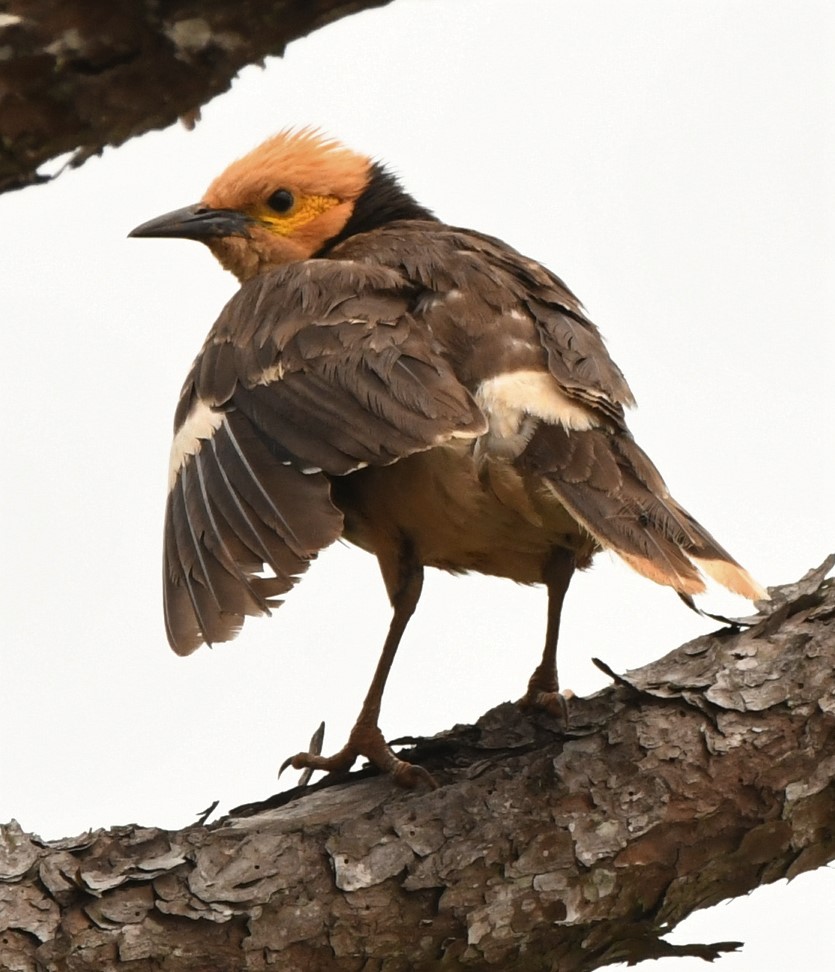
- Common Myna (Acridotheres tristis) 5 OF, gardens, parks, forages on ground, lawns, stubble, widespread.
- Dark-sided Thrush (Zoothera marginata) 1 BEF understory and ground, BNF (photo).

- Green Cochoa (Cochoa viridis) ? 1 vocal (unseen – requires confirmation) BEF, 3LP.
- Large Niltava (Niltava grandis) 3 ad, imm, BEF middle level, most active in warmer, late mornings, 3LP (photo).

- Snowy-browed Flycatcher (Ficedula hyperythra) 1 BEF middle understory and ground, BNF (photo).

- Verditer Flycatcher (Eumyias thalassinus) 1 upper levels, edge of BEF, CF, 3LP, TN (photo).

- White-tailed Blue Robin (Myiomela leucura) 2 (ad, imm) BEF understory and ground, BNF (photo).

- Langbian Lesser Shortwing (Brachypteryx langbianensis) 1 BEF understory and ground, BNF (photo).

- White-crowned Forktail (Enicurus leschenaulti) 1 (imm) BEF understory and ground, BNF (photo).

- Gray Bushchat (Saxicola caprata) 3 (ad,imm) understory edge of BEF and CF, 3LP, TN, TL (photo).

- Asian Fairy Bluebird (Irena puella) 2 (m,f) BEF edge with fruiting trees, TN (photo).

- Fire-breasted Flowerpecker (Dicaeum ignipectus) 1 (f) BEF edge, msf, 3LP.
- Streaked Spiderhunter (Arachnothera magna) 1 vocal, fast moving through middle and lower middle levels of BEF, sometimes in msf, 3LP, TN.
- Langbian Sunbird (Aethopyga johnsi) 2 (m,f) flowering melastoma and other shrubs, second-growth at BEF and CF edge, 3 LP, LB, TN (photo).
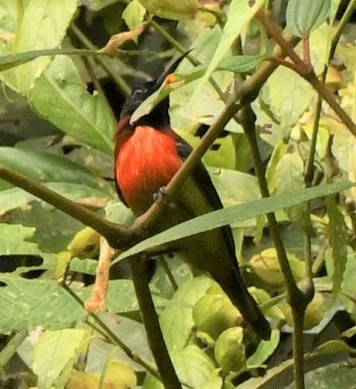
- Annam Sunbird (Aethopyga annamensis) 2 (m,f) flowering melastoma and other shrubs, second-growth, OF, edge of BEF and CF, 3LP, TN, LB, TL (photo – see intro).
- Greater Crimson Sunbird (Aethopyga seheriae) 3 (m, f, imm) in red flowering ornamental shrubs, DB (photo).

- Streaked Weaver (Ploceus manyar) 1 (m) in clump of tall grass, weedy vacant lot, DL6 (7/6/19).

- White-rumped Munia (Lonchura striata) 5 (ad, imm) gregarious, weedy fields, agriculture, tall grass with seeds, edge of BEF, CF, DL6, TN, TL Photo).
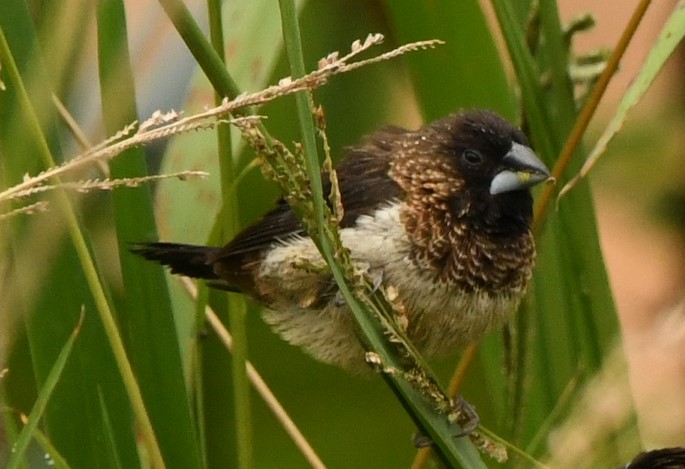
- Scaly-breasted Munia (Lonchura nisoria) 8 gregarious, often with WRMU, widspread, second-growth, gardens, OF, DL6, DUC, DBG, 3LP, TN, TL (photo).

- Indian Sparrow (Passer indicus) 3 (m,f) gregarious, less common and abundant as EUTS but sometimes found in same areas, gardens, second-growth, OF, agriculture, villages & towns, DL6.
- Eurasian Tree Sparrow (Passer montanus) 10 (m,f) gregarious, widespread in gardens, second-growth, agriculture, towns and cities.
- Vietnamese Greenfinch (Chloris monguilloti) 8 gregarious in CF canopy and in BEF fruiting trees, 3LP, TN, TL.
- Red Crossbill (Loxia curvirostra meridionalis) 2 (m,f) gregarious, CF on ground and in canopy, TL (photo).
